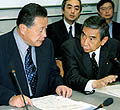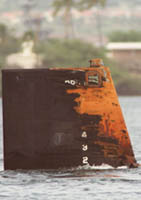By Jennifer Hiller
Advertiser Staff Writer
The United States formally apologized to Japan yesterday for the sinking of the Ehime Maru as the Navy faced troubling questions about why one of its newest and most sophisticated submarines burst from the sea and smashed the Japanese ship without first detecting its presence.
The Coast Guard continued its search for nine people missing after the nuclear-powered submarine USS Greeneville collided with the Japanese fisheries training vessel and sank it Friday afternoon nine miles south of Diamond Head.
 |
| Japanese Foreign Minister Yohei Kono, right, talked to Prime Minister Yoshiro Mori during an emergency meeting at Mori's official residence yesterday on the Ehime Maru sinking.
Kyodo News Service photo via Associated Press |
President Bush apologized to Japan and Secretary of State Colin Powell phoned Japanese Foreign Minister Yohei Kono to express his regrets.
In Japan, Prime Minister Yoshiro Mori established an emergency command center at his official residence to monitor developments. Japanese television showed images of the country in mourning but also reflected anger and astonishment among citizens who said they were disturbed by what they saw as the carelessness of the submarine crew.
The Navy said it has reassigned the captain of the Greeneville, Cmdr. Scott Waddle of Austin, Texas. He had been the skipper of the submarine since March 1999.
Adm. Thomas Fargo, commander of the U.S. Pacific Fleet and a former submarine officer, said yesterday that the Greeneville was executing an emergency surfacing drill when it struck the Ehime Maru.
"While it is not yet known how this accident occurred, it is tragic and regrettable," Fargo said. "I want to express my apologies to those involved in the incident, their families and the government of Japan."
He said the Navy investigation would be led by Rear Adm. Charles Griffiths Jr., commander of Submarine Group 9 out of Bangor, Wash. "We want to know what happened," Fargo said.
Sonar system key issue
One of the key issues for investigators is whether the submarine’s sonar system was working properly and whether it should have detected the training ship on the surface.
The captain of the Ehime Maru, Hisao Onishi, said yesterday that his ship’s engines were running when the collision occurred.
That suggests that the vessel should have been easier for the Greeneville’s sonar to detect. Submarine experts say sonar, which tracks objects through sounds, can miss vessels if they are not running their engines.
They also said the effectiveness of sonar can be diminished by sea swells, which were running 6 to 8 feet at the time of the accident.
The Greeneville was on a routine cruise that left Pearl Harbor at 8 a.m. Friday and was to return at 3 p.m., according to Jon Yoshishige, a spokesman for the U.S. Pacific Fleet. In addition to the crew, 15 civilians and one military person were on the cruise to observe operations as part of the Navy’s community relations effort, he said.
The Navy declined to release the identities of the civilians or to say who they represented.
Visible damage
The Greeneville stayed at the scene overnight and moved into port at 9:56 a.m. yesterday, escorted by a single tug.
Damage to its rudder was clearly visible, a swath of orange against the black hull, but it appeared minimal: scrapes and gashes in the metal. Also visible was a scrape amidship on the port side of the submarine, but its cause was not immediately known, said Cmdr. Bruce Cole, a Navy spokesman.
 |
| Damage and paint was visible on the rudder, above, of the USS Greeneville yesterday.
Bruce Asato • The Honolulu Advertiser |
The rudder damage as well as eyewitness accounts suggested that the Greeneville may have been diving quickly when its tail sliced through the hull of the Ehime Maru, flooding the lower decks in minutes.
In normal and emergency surfacings, the submarine’s crew conducts a sonar scan and a visual check through the periscope before surfacing, submarine experts said.
But the emergency procedure is faster than normal. After making the sonar and visual inspection, the submarine dives and then surfaces again quickly, said Lt. Cmdr. Dave Werner, public affairs officer for the commander of submarine forces in the Pacific.
Ehime Maru survivors said the 174-foot vessel, used to train high school students as commercial fishermen, sank in 10 minutes. Among the missing are four teenagers, two teachers and three crew members.
While the Coast Guard rescued 26 of the crew members and students on board, the search for survivors continued unsuccessfully yesterday: only debris was found.
Coast Guard Petty Officer Lauren Smith said the Coast Guard by yesterday afternoon had searched more than 1,453 square miles, an area larger than the land mass of Rhode Island. "We remain hopeful that there are survivors and we will continue our search," Smith said.
‘Deepest regrets’
Fargo met with a top Japanese Foreign Ministry official in Honolulu yesterday morning and formally apologized for the accidental sinking. With more than 35 journalists, most of them Japanese, squeezed into a parlor at the Japanese Consulate to record the first few minutes of the meeting, an earnest-looking Fargo entered and immediately told Yoshitake Sakurada, vice minister of foreign affairs, that he had come to express his "deepest regrets."
 |
| Adm. Thomas Fargo, commander of the U.S. Pacific Fleet, shakes hands with Yoshitake Sakurada, Japan's vice minister of foreign affairs. Fargo met with Sakurada at the Japanese Consulate in Nu'uanu to apologize for the sinking of the Ehime Maru.
Associated Press |
After the pair spoke privately for an additional 30 minutes, Fargo left without public comment. But Sakurada stood on the porch of the facility and told Japanese media members that Fargo had offered a complete apology and had admitted that the American submarine had been 100 percent at fault.
Another Japanese official, Koji Haneda, a division director for the ministry’s North American affairs bureau, said some family members of the men on the ship were expected to start arriving in Honolulu today. He did not specify how many were likely to arrive or whether they might be related to those who are missing.
Family members in Uwajima, Japan, where the fisheries school is based, began boarding planes for Honolulu.
Many of the survivors stayed at the Ala Moana Hotel on Friday night. They came downstairs yesterday to eat at the hotel’s Plantation Cafe shortly before noon, still wearing the blue uniform overalls given to them by the Coast Guard and appearing exhausted after yesterday’s ordeal.
Protected by hotel security, the crew members moved through a huge crowd of Japanese media to get to the restaurant, then later left through a rear door.
Hiju Ashikaga, a Honolulu resident volunteering as a Japanese interpreter, said Uwajima Fisheries High School principal Ietaka Horita, whose students were on the ship, arrived at the hotel yesterday. Ashikaga said Horita was tired and worried about the missing students.
At the Ocean Resort Hotel where other survivors stayed, a Navy chaplain and counselors offered help.
According to the Coast Guard, the Ehime Maru sank in waters 1,866 feet deep.
Survivors in good condition
The Coast Guard plucked the 26 survivors from the water and brought them back to Sand Island, where they arrived diesel-soaked and shivering. Some were treated for hypothermia and others for minor injuries.
Three of four survivors taken to Straub Hospital on Friday - two 17-year-old boys and a 51-year-old man - were released. A 22-year-old man remains hospitalized but was upgraded to good condition yesterday morning, a hospital spokeswoman said. All eight survivors taken to Kaiser Moanalua Medical Center were released Friday night.
During yesterday’s search, winds were 18 miles per hour from the northeast in 3- to 5-foot seas. The water temperature was 77 degrees, the Coast Guard said. Along with Coast Guard and Navy ships and planes, a Japanese training vessel, the Nippon Maru, assisted in the search. The Nippon Maru is operated by the Ministry of Transport in Japan and is visiting Honolulu Harbor.
Gov. Ben Cayetano yesterday expressed his sympathies to those who were aboard the Ehime Maru and their families. "The people of Hawai‘i are shocked and saddened by this terrible accident," Cayetano said. "Our heartfelt thoughts and prayers are with the families of those whose fate remain unknown. I would like to thank the rescuers for their quick response in bringing the survivors safely back to shore."
Separate investigations will be conducted by the Coast Guard and the NTSB, which sent five investigators to Honolulu yesterday from its Office of Maritime Safety in Washington, D.C. NTSB spokesman Ted Lopatkiewicz said the investigation will be conducted in much the same way an airplane crash is analyzed.
They will interview as many of the survivors as possible from the Ehime Maru as well as Greeneville crew members. The members of the NTSB team, which will be headed by Jim Scheffer, are all experienced marine accident investigators, Lopatkiewicz said. Each of the investigators will concentrate on different aspects of the collision.
Debris collected
Searchers retrieved numerous pieces of "collision debris" from the water yesterday, Coast Guard officials said, including life raft cases, life rafts and life jackets. All of the recovered items will be stored in a warehouse at the Coast Guard station on Sand Island to await examination by the NTSB investigators.
The USS Greeneville, named after a northeastern Tennessee town, is the 61st Los Angeles-class submarine and was christened on Sept. 17, 1994. It was commissioned a U.S. naval warship at Norfolk Naval Base, Va., on Feb. 16, 1996. Greeneville changed home port to Pearl Harbor in March 1997.
The Greeneville is capable of conducting myriad missions, including undersea warfare, surface warfare, intelligence gathering, mining, search and rescue, land attack and delivery of special forces. It is capable of launching torpedoes, Tomahawk land and attack cruise missiles and mines.
Staff writers Mike Gordon, Glen Scott, Alice Keesing, Scott Isikawa, David Waite and Kevin Dayton, Washington correspondent Susan Roth, the Associated Press and the Los Angeles Times contributed to this report.
You can reach Advertiser military affairs reporter Mike Gordon at 525-8012 or e-mail him at mgordon@honoluluadvertiser.com. Staff writer Jennifer Hiller can be reached at 525-8084 or at jhiller@honoluluadvertiser.com
[back to top] |



